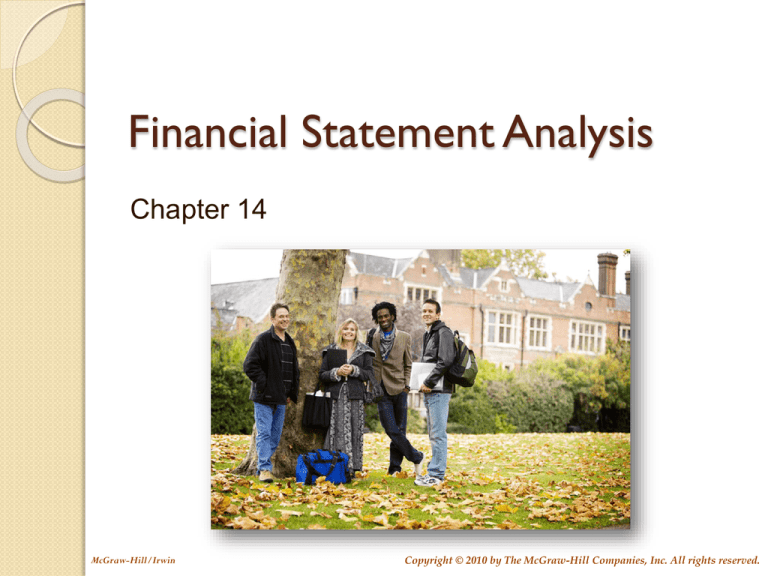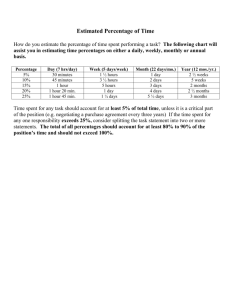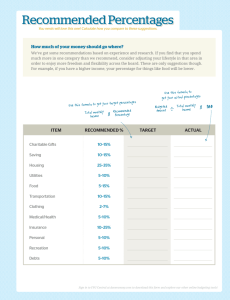
Financial Statement Analysis
Chapter 14
McGraw-Hill/Irwin
Copyright © 2010 by The McGraw-Hill Companies, Inc. All rights reserved.
Tools of Analysis
Dollar &
Trend
Percentage
Percentages
Changes
Component
Percentages
Ratios
14-2
Ratios
A ratio is a simple mathematical expression
of the relationship between one item and another.
Along with dollar and percentage changes,
trend percentages, and component percentages,
ratios can be used to compare:
Past performance to
present performance.
Other companies to
your company.
14-3
Working Capital
Current Assets – Current Liabilities =
Working Capital
14-4
Current Ratio
This ratio measures the
short-term debt-paying
ability of the company.
Current
=
Ratio
Current Assets
Current Liabilities
14-5
Quick Ratio
Quick
Ratio
Quick Assets
=
Current Liabilities
Quick assets are cash, marketable
securities, and receivables.
This ratio excludes current assets
such as inventories and prepaid
assets that may be difficult to
quickly convert into cash.
14-6
Measures of Profitability
An income statement can be prepared in either a
multiple-step or single-step format.
The single-step format
is simpler. The multiple-step
format provides more detailed
information.
14-7
Income Statement (Single-Step)
Proper Heading
Revenues
& Gains
Expenses
& Losses
Remember
to compute
EPS.
Babson Builders, Inc.
Income Statement
For the Year Ended 12/31/09
Revenues and gains:
Sales, net
Interest income
Gain on sale of plant assets
Total revenues and gains
Expenses and losses:
Cost of goods sold
Selling Expenses
General and Admin. Exp.
Depreciation
Interest
Income taxes
Loss: sale of investment
Total expenses & losses
Operating income
$
$
$
785,250
62,187
24,600
872,037
$
743,650
128,387
351,800
197,350
78,500
17,500
27,000
62,500
9,000
14-8
Income Statement (Multiple-Step)
Proper Heading
Gross Margin
Operating Expenses
Non-operating Items
Remember
to compute
EPS.
Babson Builders, Inc.
Income Statement
For the Year Ended 12/31/09
Sales, net
Cost of goods sold
Gross margin
Operating expenses:
Selling expenses
General & Admin.
Depreciation
Income from Operations
Other revenues & gains:
Interest income
Gain
Other expenses:
Interest
Loss
Income before taxes
Income taxes
Net income
$
$
$
$
$
785,250
351,800
433,450
$
293,350
140,100
197,350
78,500
17,500
62,187
24,600
86,787
27,000
9,000
$
$
(36,000)
190,887
62,500
128,387
14-9
Earnings Per Share
Net Income – Preferred Dividends
= EPS
Average Shares of Capital Stock Outstanding
14-10
Price-Earnings Ratio
Current Market Price of one Share of Stock
Earnings Per Share
= P/E
The measure shows us the relationship between earning
of the company and the market price of its stock.
14-11
Return On Assets (ROA)
This ratio is generally considered
the best overall measure of a
company’s profitability.
ROA
Operating
=
÷ Average total assets
Income
= $ 53,690 ÷ ($300,000 + $346,390) ÷ 2
=
16.61%
14-12
Return On Equity (ROE)
This measure indicates how well the
company employed the owners’
investments to earn income.
ROE
= Net income ÷ Average total equity
14-13
Dividend Yield
Dividend
Yield Ratio
=
Dividends Per Share
Market Price Per Share
This ratio identifies the return, in
terms of cash dividends, on the
current market price of the stock.
14-14
Accounts Receivable Turnover
Rate
Accounts
Receivable
Turnover
=
Net Sales
Average Accounts Receivable
This ratio measures how many
times a company converts its
receivables into cash each year.
Days to Collect = 365 / Turn
14-15
Inventory Turnover Rate
Inventory
Turnover
=
Cost of Goods Sold
Average Inventory
This ratio measures the
number of times merchandise
inventory is sold and replaced
during the year.
Days to Sell = 365 / Turn
14-16
Operating Cycle
Cash
Accounts
Receivable
Inventory
2. Sale of merchandise on account
14-17
Debt Ratio
A measure of creditor’s long-term risk.
The smaller the percentage of assets
that are financed by debt, the smaller
the risk for creditors.
Total Liabilities / Total Assets
14-18
Interest Coverage Ratio
Times
Interest
Earned
=
Income before Interest
and Income Taxes
Interest Expense
This is the most common
measure of the ability of a firm’s
operations to provide protection
to the long-term creditor.
14-19
Dollar and Percentage Changes
Dollar Change:
Dollar
Change
=
Analysis Period
Amount
–
Base Period
Amount
Percentage Change:
Percent
Change
=
Dollar Change
÷
Base Period
Amount
14-20
Dollar and Percentage Changes
Facebook Partial Financials
Balance Sheet
Period Ending
31-Dec-12 31-Dec-11 31-Dec-10
A ssets
Current Assets
Cash And Cash Equivalents
2,384,000
1,512,000
1,785,000
Short Term Investments
7,242,000
2,396,000
-
1,170,000
547,000
373,000
-
-
-
471,000
149,000
88,000
Net Receivables
Inventory
Other Current Assets
T o tal C urrent A ssets
11,267,000
4,604,000
2,246,000
Using 2012 and 2011 data
Dollar Change
% Change
872000
58%
4846000
202%
623000
114%
322000
216%
6663000
145%
14-21
Trend Percentages
Trend analysis is used to reveal patterns in
data covering successive periods.
Trend
=
Percentages
Analysis Period Amount
Base Period Amount
14-22
Trend Percentages
Facebook, Inc.
Income Statement
Period Ending
T o t a l R e v e nue
5 ,0 8 9 ,0 0 0
Co st o f Revenue
3 1- D e c - 11
3 ,7 11,0 0 0
1,364,000
G ro s s P ro f it
GO
GO
3 1- D e c - 12
3 ,7 2 5 ,0 0 0
860,000
2 ,8 5 1,0 0 0
3 1- D e c - 10
1,9 7 4 ,0 0 0
493,000
1,4 8 1,0 0 0
31-Dec-12 31-Dec-11 31-Dec-10
Total Revenue
Cost of Revenue
Gross Profit
258%
188%
100%
277%
252%
174%
193%
100%
100%
Base Year 2010
14-23
Component /Common Sized Percentages
Examines the relative size of each item in the
financial statements compared to the base amount.
Component
Percentage
=
Analysis Amount
Base Amount
Financial Statement
Balance Sheet
Income Statement
Base Amount
Total Assets
Revenues
14-24
Facebook, Inc.
Income Sta te me nt
Period Ending
T o t a l R e v e nue
C o s t o f R ev enue
G ro s s P ro f it
3 1- D e c - 12
5 ,0 8 9 ,0 0 0
1,364,000
3 ,7 2 5 ,0 0 0
Component
Percent
100.0%
26.8%
73.2%
Operat ing Expens es
R es earc h D ev elo pm ent
1,399,000
27.5%
Selling General and
A dm inis t rat iv e
1,788,000
35.1%
O pe ra t ing Inc o m e o r Lo s s
T o t al Ot her
Inc o m e/ Expens es N et
Earnings B ef o re Int eres t
A nd T axes
Int eres t Expens e
Inc o m e B ef o re T ax
Inc o m e T ax Expens e
M ino rit y Int eres t
N et Inc o m e F ro m
C o nt inuing Ops
N e t Inc o m e
5 3 8 ,0 0 0
7,000
545,000
51,000
494,000
441,000
-21,000
32,000
3 2 ,0 0 0
10.6%
0.1%
10.7%
1.0%
9.7%
8.7%
-0.4%
0.6%
0.6%
On the income statement, everything is a percent of revenue
On the balance sheet, everything is a percent of total assets
14-25
14-26



